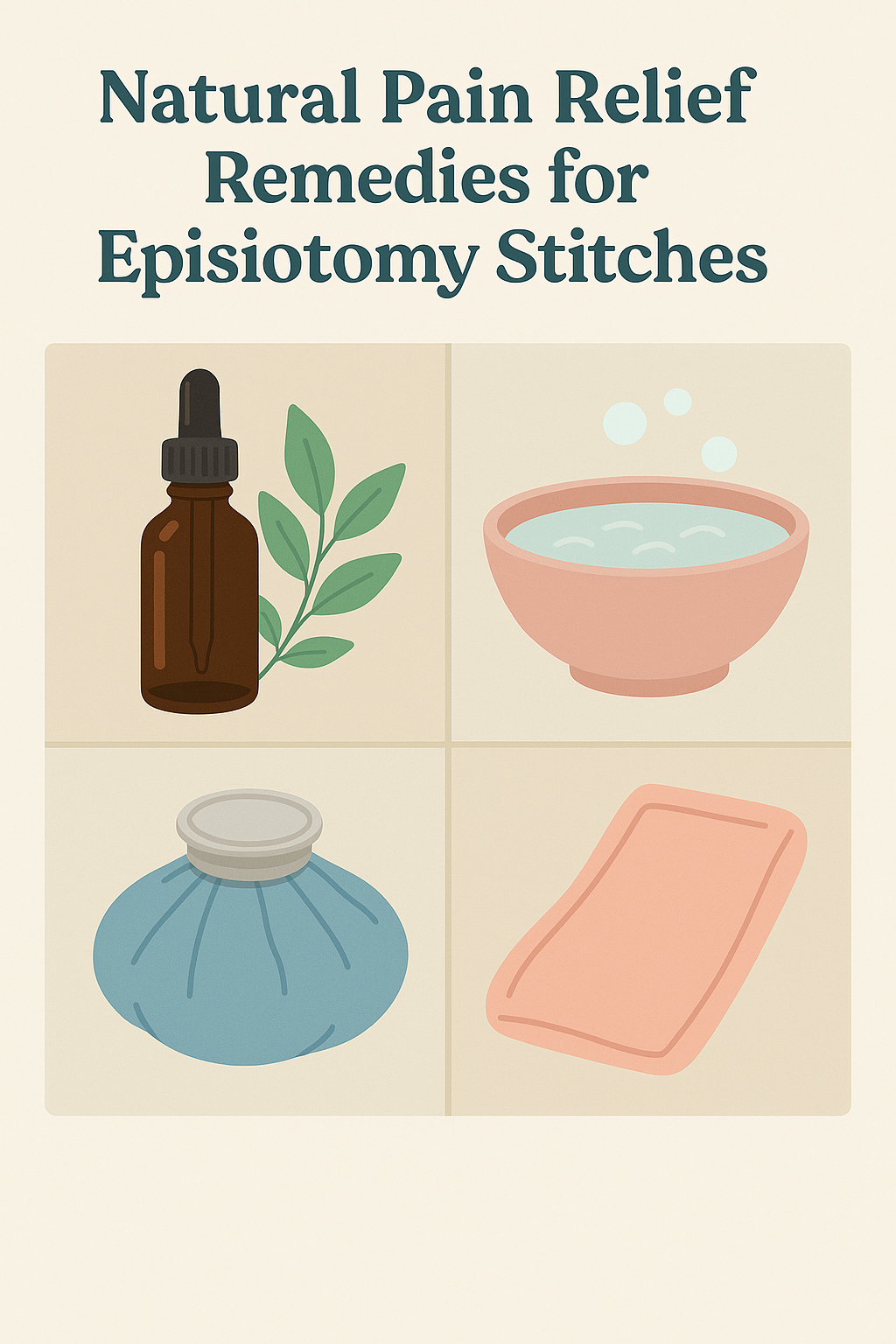What is Episiotomy?
A frequent procedure used during childbirth to aid in delivery is episiotomy. Although it may be helpful in some circumstances, the stitches inserted in the perineum sometimes cause discomfort throughout the healing phase. To ensure a smooth recovery, it is crucial to comprehend the reasons of post episiotomy pain and investigate both medical and natural management techniques for episiotomy stitches pain relief.
Causes and Symptoms of Episiotomy Pain
Causes of Episiotomy Pain
- Surgical incision made during childbirth
- Tearing or stretching of perineal tissues
- Infection at the incision site
- Nerve damage or irritation
- Poor wound healing
- Hematoma or swelling near the incision
- Pressure from sitting or movement
- Scar tissue formation
- Sharp or throbbing pain at the incision site
- Swelling or tenderness in the perineal area
- Burning sensation during urination
- Pain while sitting or walking
- Discomfort during bowel movements
- Pain during sexual intercourse
- Redness, warmth, or discharge indicating infection
- Persistent soreness beyond the normal healing time
Pain typically peaks in the first 3–5 days after the procedure and gradually subsides as the healing progresses.
Effective Pain Relief Strategies for Episiotomy Stitches
Natural Pain Relief Remedies
Several natural remedies can help alleviate pain and promote healing following an episiotomy.

- Sitz Baths: Taking a warm sitz bath is a soothing option that can provide relief. Adding lavender oil or Epsom salts to the water can enhance relaxation and help reduce swelling in the affected area.
- Aloe Vera: Known for its cooling and anti-inflammatory properties, aloe vera can be applied to the skin around the sutures to calm irritation and promote healing.
- Coconut Oil: With its moisturizing and antibacterial properties, coconut oil helps keep the area hydrated, preventing infection and facilitating faster recovery.
- Cold Compresses: Applying a cold compress wrapped in a towel for 10 to 15 minutes can help reduce swelling and temporarily numb discomfort, providing much-needed relief during the healing process.
Medical Pain Relief Options
In some cases, medical interventions may be necessary to manage pain more effectively during the recovery process.
- Over-the-Counter Pain Relievers: Medications such as acetaminophen or ibuprofen can be useful in reducing inflammation and alleviating discomfort. These over-the-counter options provide accessible relief for mild to moderate pain.
- Topical Numbing Creams: For targeted relief, lidocaine-containing creams can be applied to the affected area. These creams temporarily numb the region, offering short-term relief from pain.
- Prescription Painkillers: In cases of more severe pain, a doctor may prescribe stronger medications to provide more effective pain control and support the recovery process.
Additional Methods for Pain Relief
There are other methods that can aid in alleviating pain and promoting healing during recovery.
- Witch Hazel Pads: Witch hazel is known for its anti-inflammatory and soothing properties, making it a beneficial remedy for relieving pain and itching around sutures. Using witch hazel pads can help reduce irritation in the perineal area, providing comfort during the healing process.
- Pelvic Rest: During the recovery phase, it is important to minimize physical activity to avoid placing unnecessary strain on the perineal region. Specifically, avoiding lifting heavy objects and limiting activities that could put pressure on the area can help prevent tension and promote more effective healing.
Rest and Proper Posture: Key Factors in Pain Relief
Rest and posture are essential components of the healing process, particularly after an episiotomy.
Prioritize Rest
Adequate rest is crucial for promoting recovery and minimizing the risk of complications. During the initial weeks, it’s important to lie down as much as possible to reduce pressure on the healing area and allow the body to rest and heal effectively.
Avoid Prolonged Sitting
Sitting for extended periods can place pressure on the perineal area, which can intensify pain and slow recovery. To alleviate discomfort, consider using cushions or supportive pillows when sitting, as they can help distribute pressure more evenly and provide additional comfort.
Use Proper Positioning
When resting, opting for a side-lying position is ideal as it helps minimize pressure on the perineal area. This positioning allows the body to heal without exacerbating discomfort, providing a more comfortable recovery experience.
How to Prevent Infection After an Episiotomy?
Helping someone recover from an episiotomy involves careful attention to hygiene and comfort. Always keep the perineal area clean by gently rinsing with warm water after using the restroom. Avoid using scented products or harsh soaps that may irritate the skin. If needed, use soft, fragrance-free wipes for gentle cleaning.
Encourage frequent changing of maternity pads every 4 to 6 hours to prevent the buildup of moisture and bacteria. Use pads designed for postpartum recovery, as they are more absorbent and less irritating.
After washing, allow the area to fully air dry or gently pat dry with a soft towel. Avoid covering the area with damp fabric, as trapped moisture can increase the risk of infection. Loose, breathable underwear made of cotton is ideal to keep the area dry and comfortable.
World Health Organization (WHO) recommends episiotomy rates should not exceed 10% of all vaginal deliveries.

Traditional Pain Relief Practices in Pakistan
In Pakistan, many mothers also turn to traditional remedies to alleviate pain and promote healing:
Ajwain (Carom Seeds)
Ajwain is widely recognized for its potent anti-inflammatory and analgesic properties. Traditionally used in postpartum care, ajwain is often included in warm herbal sitz baths or perineal steam treatments. It helps soothe discomfort following an episiotomy by reducing localized swelling and promoting blood circulation to the affected area. Its natural antimicrobial effects also make it useful in preventing minor infections and supporting overall healing.
Turmeric
Turmeric, rich in the compound curcumin, is a powerful natural remedy with anti-inflammatory, antibacterial, and antioxidant properties. It plays a valuable role in postpartum recovery by accelerating tissue repair and lowering the risk of infection. Often consumed in warm milk or applied topically in paste form, turmeric enhances the body’s immune response and supports faster healing when used appropriately.
Warm Ghee Massage
Warm ghee, or clarified butter, has long been used in Ayurvedic practices for its nourishing and therapeutic qualities. In postnatal care, gentle massage with warm ghee around the perineal area (avoiding direct contact with stitches or open wounds) can stimulate circulation, relieve discomfort, and soften scar tissue. This method helps reduce soreness while promoting elasticity and regeneration in the healing tissue.
Caregiver Guidelines for Managing Episiotomy Infections
- Gently clean the perineal area with warm water to keep it hygienic.
- Watch for signs of infection like redness, swelling, or discharge.
- Make sure prescribed medicines are taken as directed.
- Encourage plenty of rest to support healing.
- Use cold compresses in the beginning to reduce swelling and pain.
- Later, use warm compresses or sitz baths to ease discomfort.
- Offer a diet high in fiber to help avoid constipation.
- Help the person avoid heavy lifting or hard physical work.
- Remind them to wipe from front to back after using the toilet.
- Use sanitary pads instead of tampons.
- Provide emotional support and reassurance during recovery.
When to Consult a Healthcare Provider?
While some discomfort is normal, seek medical attention if you experience persistent or severe pain that doesn’t improve with standard treatments, signs of infection such as fever, foul-smelling discharge, or increased redness around the stitches, or delayed healing with abnormal swelling. In such cases, a healthcare provider may recommend alternative treatments like antibiotic ointments, corticosteroid injections, or other interventions to manage pain or complications.
Frequently Asked Questions (FAQs)
1. How long does pain last after an episiotomy?
The pain from an episiotomy typically peaks within the first 3-5 days following the procedure. Most women experience a significant reduction in pain within 1-2 weeks. However, minor discomfort may persist for up to 6 weeks. If the pain is severe or does not subside after this period, consult your healthcare provider.
2. Can i continue breastfeeding while recovering from an episiotomy?
Yes, you can breastfeed while recovering from an episiotomy. The recovery process does not interfere with your ability to breastfeed. In fact, breastfeeding may help your uterus contract, which can promote healing.
3. Are there any long-term complications associated with episiotomies?
In most cases, episiotomies heal without any long-term issues. However, some women may experience scarring, pelvic floor dysfunction, or pain during intercourse. It is important to follow your healthcare provider’s advice for optimal healing and attend follow-up appointments to monitor your recovery.
4. What should I do if the stitches break or come loose?
If the stitches appear to break or come loose, contact your healthcare provider immediately. Depending on the severity of the issue, they may need to re-suture the area or recommend alternative treatments to promote healing.
5. Is it normal to experience pain during sex after an episiotomy?
It is common for women to experience discomfort during sex for up to several months after an episiotomy. Make sure to wait until you have received clearance from your healthcare provider before resuming sexual activity. Using lubricants and practicing gentle intimacy can also help alleviate discomfort.
6. Can episiotomy pain be prevented in future deliveries?
While some episiotomies are medically necessary, there are steps you can take to reduce the likelihood of needing one in future deliveries, such as perineal massage during pregnancy, staying active, and following the guidance of your healthcare provider regarding delivery positions and techniques.

 Medically reviewed by
Medically reviewed by